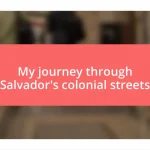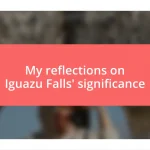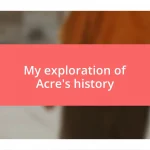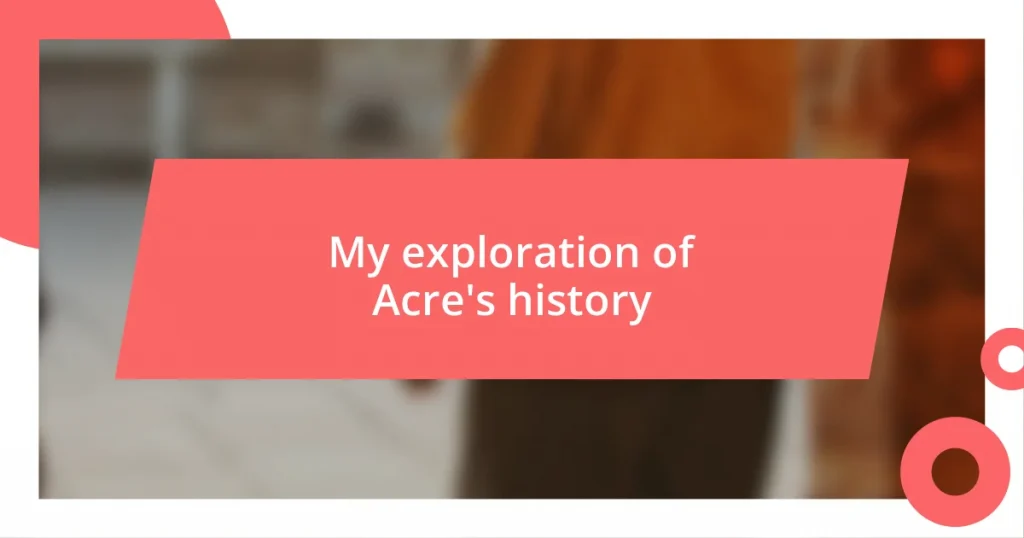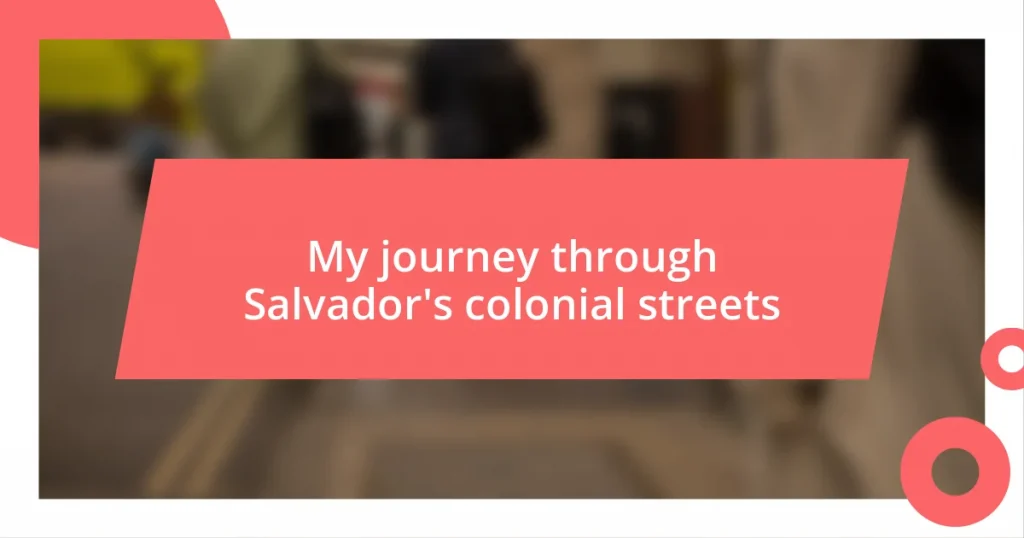Key takeaways:
- The capture of Acre by Crusaders in the 12th century established it as a significant military stronghold and cultural melting pot.
- The fall of Acre in 1291 marked the end of Crusader control in the Holy Land, significantly altering regional power dynamics.
- Modern developments focus on revitalizing historical sites and promoting sustainable tourism, preserving Acre’s cultural identity while enhancing visitor engagement.
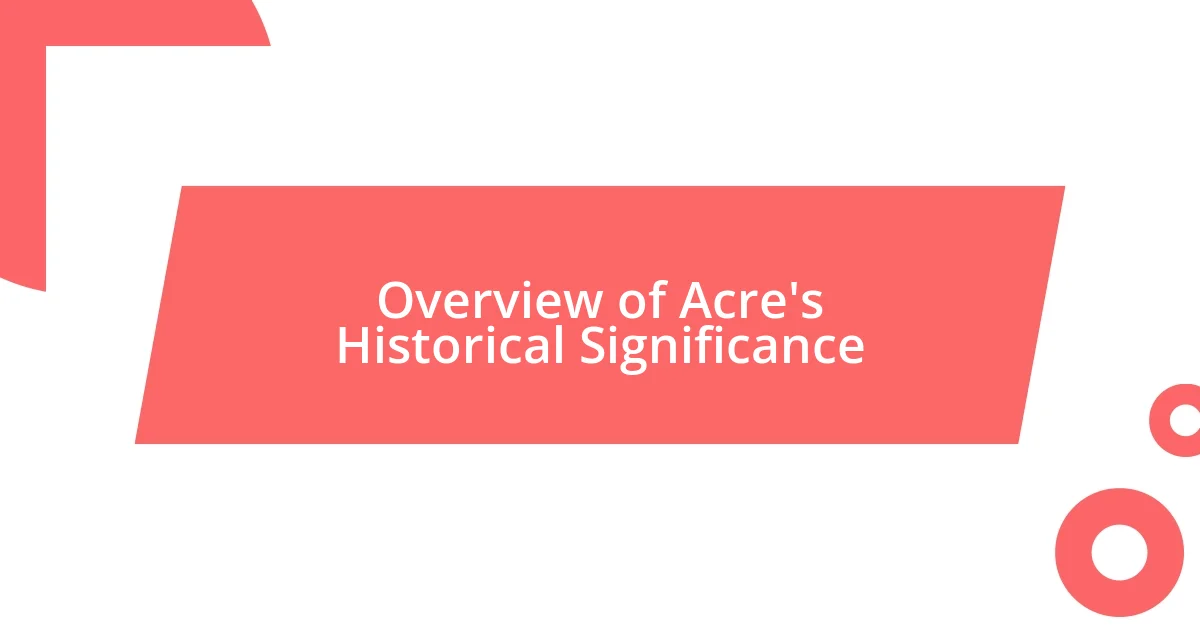
Overview of Acre’s Historical Significance
Acre, a city nestled along the Eastern Mediterranean coast, has played a pivotal role in shaping regional history. It’s fascinating to think about the countless civilizations that have marked their presence there—from the ancient Phoenicians to the Crusaders. Each layer of history feels like a whisper of the past, inviting us to wonder about the lives of those who walked its streets.
What strikes me is the strategic significance this city held throughout various periods, particularly during the Crusades. As I learned more about its fortifications and sieges, I couldn’t help but feel a sense of awe. It’s easy to imagine the tension in the air as armies clashed for control of this vital port. Does it not evoke a curiosity about what drove these historical figures to risk everything for Acre?
In addition to military exploits, Acre has served as a melting pot of cultures. When I visited the city, I was overwhelmed by the blend of architecture and traditions, which reflect centuries of coexistence among different peoples. This vibrant tapestry is a testament to Acre’s role as a crossroads of humanity, illustrating how deeply interconnected our histories are. Just think about it—what stories could preserve the echoes of trade, migration, and conflict that have defined this city?
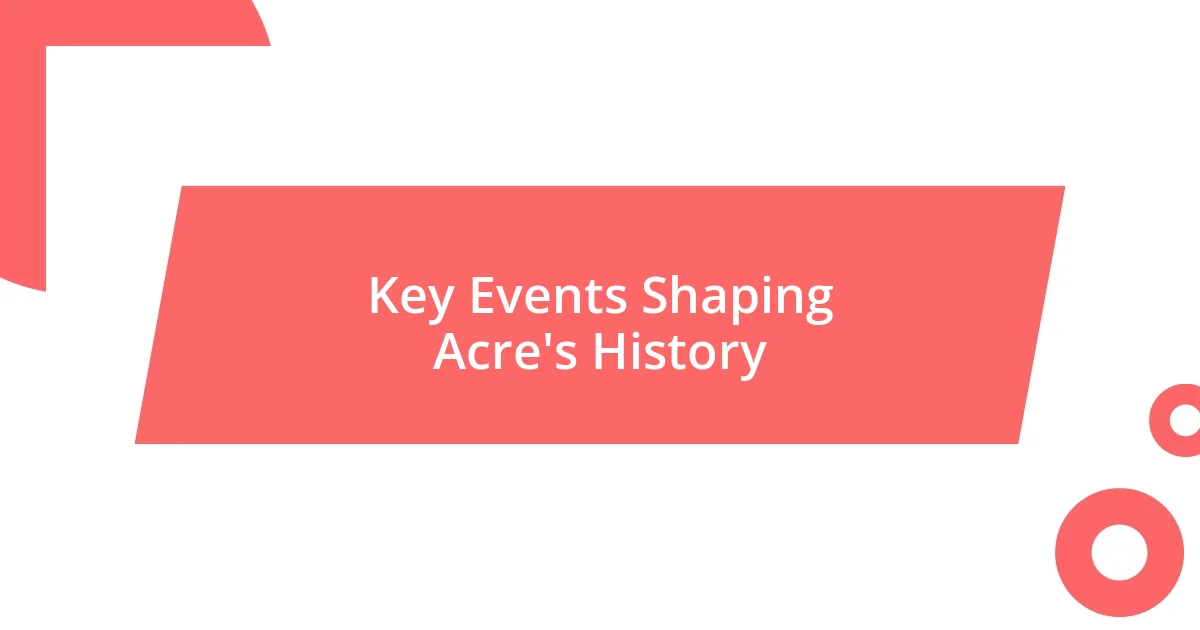
Key Events Shaping Acre’s History
Several key events have shaped Acre’s history, with each one leaving a lasting impact on the city and its surroundings. One of the earliest significant moments was in the 12th century when the Crusaders captured Acre, marking it as a vital stronghold in their quest for control over the Holy Land. This event not only established Acre’s military importance but also transformed it into a melting pot where different cultures mingled. On my visit, I could almost hear the echoes of the past as I wandered through the narrow cobblestone streets, envisioning the bustling marketplaces filled with traders.
Acre’s subsequent reconquests and sieges further illustrate its tumultuous history. The city changed hands multiple times, especially during the battles between the Crusaders and Muslim forces. This cycle of conflict shaped the geopolitical landscape of the region and deeply influenced its architectural style. Here are some pivotal events:
- 1187: Saladin’s forces besieged and regained control of Acre from the Crusaders.
- 1291: The fall of Acre marked the end of Crusader presence in the region, triggering a significant shift in power dynamics.
- 1799: Napoleon’s failed siege of Acre showcased its enduring fortifications and strategic importance.
- 1948: The establishment of the State of Israel led to further changes in Acre’s demographics and cultural fabric.
As I learned about these events, I couldn’t help but feel a blend of admiration and sorrow. The struggles that defined Acre’s history made me realize how complex and intertwined our narratives are, echoing the rich stories waiting to be uncovered in this remarkable city.
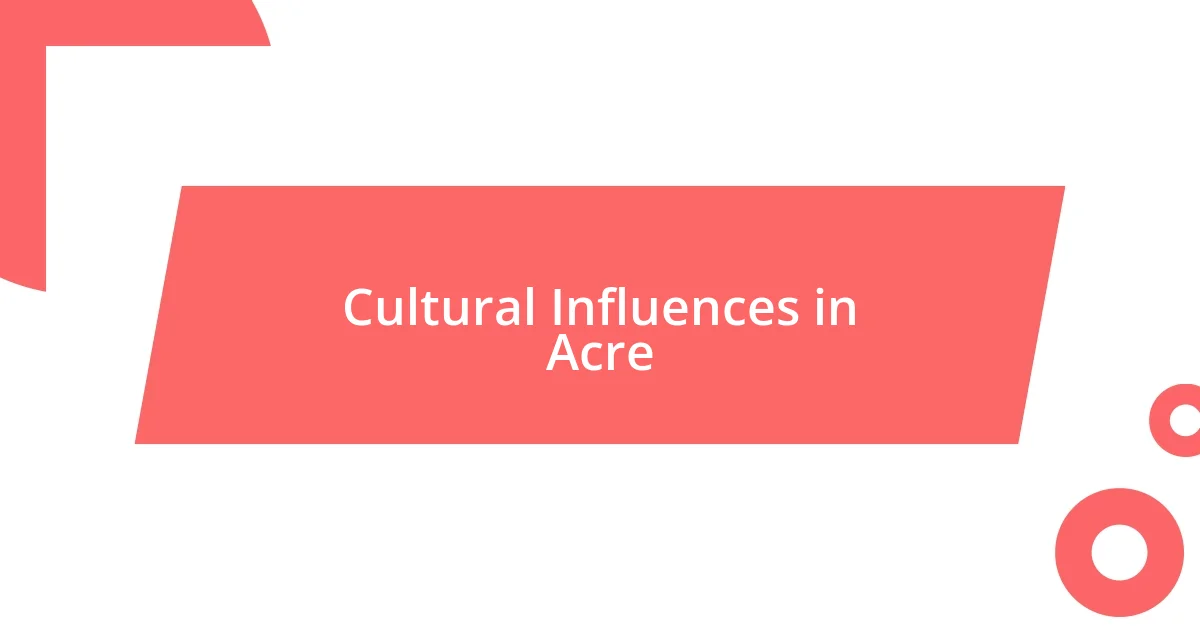
Cultural Influences in Acre
Acre’s cultural influences come alive through its diverse population and an array of traditions that have interwoven over centuries. Walking through the city, I was struck by the vivid colors of the markets, bustling with stalls selling spices, textiles, and handcrafted goods from different cultures. Each corner seemed to tell a story steeped in the exchanges between Jewish, Christian, and Muslim communities. I often find myself reflecting on how these shared experiences forge a unique identity that speaks to both resilience and connection.
What particularly impressed me during my visit was witnessing the interplay of architectural styles. I wandered through the narrow streets flanked by ancient Crusader structures, which stood proudly beside ornate Ottoman and British buildings. This blend made me think about how architecture can symbolize the convergence of diverse cultures. It’s a reminder that, despite our differences, our histories are intertwined. Isn’t it fascinating how a simple structure can encapsulate centuries of tradition and influence?
To deepen our understanding of Acre’s cultural tapestry, let’s take a look at the various aspects that shape its rich identity:
| Cultural Element | Description |
|---|---|
| Architecture | Mix of Crusader, Ottoman, and British styles reflecting historical influences. |
| Cuisine | Blend of Mediterranean flavors, with spices and recipes from various cultures. |
| Festivals | Celebrations from different communities, showcasing traditions and shared heritage. |

Acre During the Crusades
Acre served as a crucial battleground during the Crusades, where the clash of cultures was palpable. I remember standing by the ancient walls and imagining the fierce battles that unfolded here, particularly the dramatic siege of 1187 when Saladin reclaimed Acre from the Crusaders. It’s astonishing to think of how many lives were entwined in these conflicts, each moment shaping the destiny of not just the city, but the broader region.
The city’s year 1291 marked a significant milestone—the fall of Acre effectively ended the Crusader presence in the Holy Land. I often pondered the emotions felt by those watching their hopes and dreams crumble. Encountering stories of those final days, I couldn’t help but feel a deep sense of loss for what might have been, while also recognizing the resilience of those who rebuilt and adapted to a new era under different rulers.
Throughout my exploration, I was struck by Acre’s evolution during these tumultuous times. The remains of Crusader fortifications still stand robust, silently witnessing the ebb and flow of power. What does it say about us, I wondered, that we often dwell on the stories of conquest while overlooking the resilience born from such struggles? It’s a reminder that even amidst conflict, there is a remarkable human capacity to adapt, endure, and ultimately thrive.

Modern Developments in Acre
One of the most noticeable modern developments in Acre is the revitalization of its historical sites, which has transformed the city into a vibrant tourism hub. During my visit, I recall feeling a surge of excitement as I strolled through areas that had been meticulously restored. It was as if the past and present were dancing together, inviting visitors to explore the city’s rich history while indulging in contemporary experiences.
I was particularly intrigued by the recent emphasis on sustainable tourism, which aims to balance visitor engagement with preservation efforts. Watching local artisans showcase their crafts while narrating stories of their heritage made me appreciate their dedication to keeping traditions alive. Have you ever engaged with someone whose passion for their craft ignites a spark in you? That’s precisely how I felt, inspired by the way the community is working to ensure that progress doesn’t come at the expense of their cultural identity.
Moreover, Acre has seen the rise of innovative culinary venues that celebrate its diverse heritage. One evening, I found myself at a trendy restaurant that blended traditional flavors with modern techniques. The experience was delightful, as the chef introduced me to dishes that were both familiar and surprisingly new. It made me reflect on how food can serve as a bridge between generations, connecting us to our roots while embracing change. Isn’t it fascinating how a single meal can tell the story of a city’s evolution?
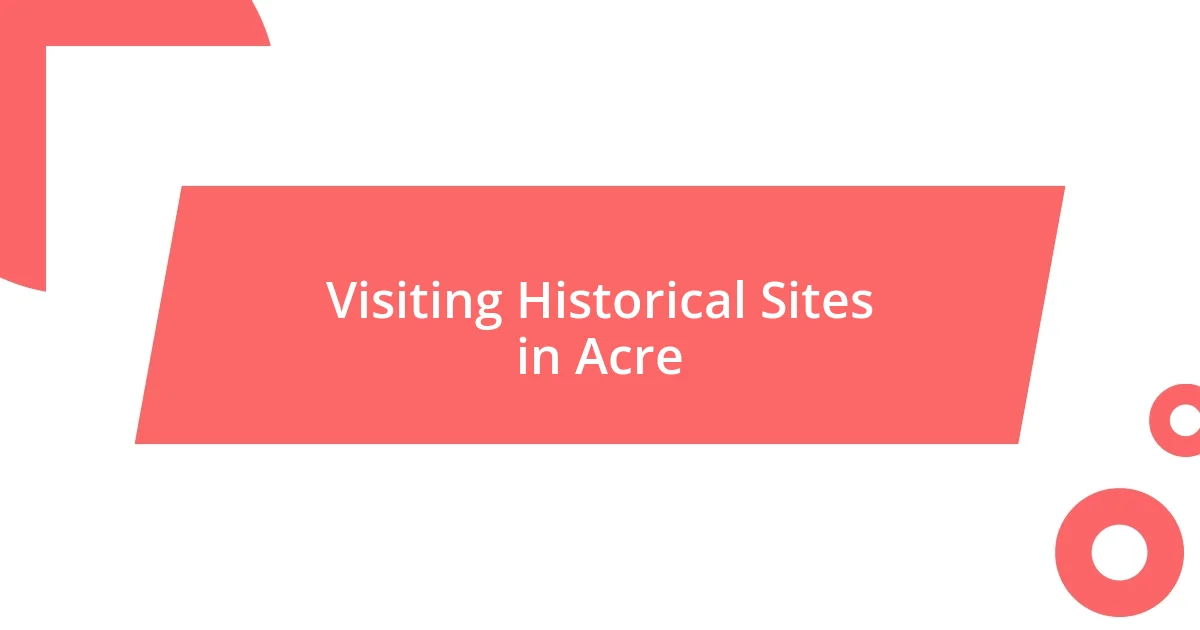
Visiting Historical Sites in Acre
Visiting the historical sites in Acre is a truly immersive experience that vividly brings the past to life. I fondly remember wandering through the Knight’s Halls, where the cool stone walls absorbed centuries of stories. As I traced my fingertips along the ancient carvings, I couldn’t help but wonder about the vibrant gatherings and the camaraderie that once filled this space. It felt almost as if I was walking in the footsteps of those who had defended their beliefs and homes.
One of my most cherished moments was standing at the Citadel, where everything seems to echo the whispers of history. As I gazed out at the stunning views of the Mediterranean Sea, I felt a blend of tranquility and awe. The juxtaposition of the serene waters against the city’s tumultuous past made me reflect on how places like this carry the weight of their history yet continue to thrive. Have you ever felt a strong sense of connection to a place just by being there?
As I explored the alleyways of the Old City, with their vibrant markets and rich aromas, I was reminded of the resilience of Acre’s spirit. The cobblestones beneath my feet had borne witness to centuries of traders, pilgrims, and conquerors. It struck me how these streets, alive with hustle and bustle, are also an invitation for us to reflect on our own journeys. Isn’t it remarkable how a simple walk through a historical site can evoke such profound thoughts on our connections to the past?

Resources for Further Exploration
One fantastic resource to deepen your understanding of Acre’s history is the local libraries and museums. When I visited the Acre Museum, I was captivated by the array of exhibits that chronicle the city’s unique past. The interactive displays allowed me to piece together the narratives of various cultures that have influenced Acre over the centuries. Have you ever found yourself lost in a museum, letting the artifacts transport you through time? It’s an experience I believe every history buff should have.
For those keen on digging deeper, I highly recommend seeking out historical walking tours. During one such tour, I had the privilege of hearing firsthand accounts from knowledgeable guides who shared their personal connections to Acre. Listening to their stories ignited my curiosity even further. Isn’t it refreshing to learn history through the eyes of those who genuinely cherish their heritage?
Lastly, don’t overlook academic journals and books focused on Acre’s multifaceted history. I recently stumbled upon a compelling book that dissected the influences of various empires in the region. Each chapter unearthed layers of complexity that changed my perspective on how history shapes identity. Have you ever read something so enlightening that it completely shifted your viewpoint? It’s incredible how literature can bridge the gap between past and present, offering insights that resonate on a personal level.

